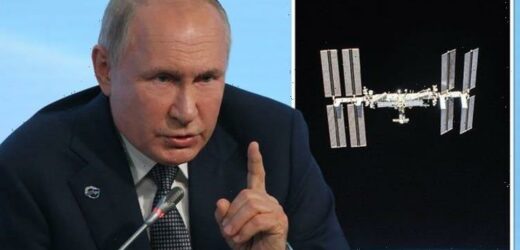Stunning NASA timelapse shows Aurora Borealis from space
We use your sign-up to provide content in ways you’ve consented to and to improve our understanding of you. This may include adverts from us and 3rd parties based on our understanding. You can unsubscribe at any time. More info
The Kremlin has been warned there will be “hell to pay” for endangering the orbital laboratory and the seven astronauts on board. The US Space Command was alerted earlier on Monday to a cloud of fast-moving objects headed on a possible collision course with the International Space Station. US officials have since confirmed more than 1,500 bits and pieces of a blown-up Russian satellite were sent hurtling past the ISS after Russia targetted one of its own satellites.
US State Department spokesman Ned Price said: “Earlier today, the Russian Federation recklessly conducted a destructive satellite test of a direct ascent and anti-satellite missile against one of its own satellites.
“The test has so far generated over 1,500 pieces of trackable orbital debris and hundreds of thousands of smaller orbital debris that now threaten the interests of all nations.”
Mr Price went on to say the missile test “will significantly increase the risk” the space station’s residents, including two Russian cosmonauts.
The missile test led to an emergency on the ISS, prompting its crew to evacuate to their docked return capsules.


The astronauts waited out the cloud of debris aboard the Russian Soyuz spacecraft and SpaceX Crew Dragon.
They were since told to resume normal activities but will have to keep some of the station’s hatches closed throughout Tuesday.
Orbital debris races around the planet at speeds of more than 17,000mph and can punch through the space station’s hull with ease.
Even tiny objects could puncture the ISS and lead to depressurisation.
Russia’s actions have been condemned by the scientific community, for putting the astronauts’ lives at risk but also for putting other satellites and spacecraft in harm’s way.
NASA: International Space Station captured passing the sun
Ocean McIntyre, a science assistant at NASA’s Jet Propulsion Laboratory (JPL), tweeted: “Aren’t there two Russian cosmonauts on board ISS right now?
“Who in their right mind would approve something like this?
“Has anyone looked at the possible near-term impacts this debris could have beyond the ISS?”
Eric Berger, book author and space editor at Ars Technica, tweeted: “Seriously, what the f*** is Russia doing shooting down its own satellite in low-Earth orbit; creating a cloud of 1,500 trackable pieces of debris, and knowingly threatening its own asset—the International Space Station. What a catastrophe.”
Jonathan McDowell, an astronomer with the Center for Astrophysics, said: “US State Dept confirms the Russian anti-satellite missile test.


“I condemned the 2007 Chinese test, the 2008 US test, the 2019 Indian test, and I equally condemn this one.
“Debris-generating antisatellite tests are a bad idea and should never be carried out.
And astronomer Phil Plait said: “Russia really super needs to speak up right now about this.
“I don’t expect honesty but their silence is very bad.
“If the debris damages any other satellites or the ISS there will be hell to pay politically.”
As of May 26, 2021, NASA estimates there are more than 27,000 pieces of orbital debris or “space junk” orbiting the planet.
These are being tracked by the Department of Defense’s global Space Surveillance Network (SSN) sensors.
However, many more bits and pieces of satellites and spacecraft that are too small to track but are big enough to endanger human life are in the near-Earth space environment.
NASA estimates there are half a million pieces of debris about the size of a marble or larger, and some 100 million pieces of debris about 0.4 inches or larger.
Source: Read Full Article

